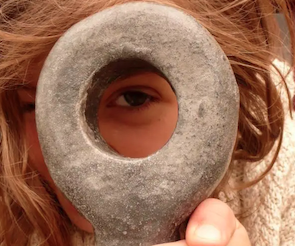
A zoetrope is an early (pre-film) form of animation, introduced in 1834 by English mathematician, William Horner, originally called the Daedalum, his designs were based on the phenakistoscope.- An even earlier form of animation that uses spinning discs with a series of continuous images to create the illusion of motion. The zoetrope gained commercial success in the 1860’s when the term was patented by an American man William E. Lincoln, who designated the patent to toy company Milton Bradley.


The zoetrope is a cylinder composed of 2 main parts, the outer cylinder is composed of narrow slits that look into the internal section. In this internal section is a second cylinder with a sequence of around 10-20 images, portraying a progressive motion, meaning when spun it creates a smooth flowing moving image. In order to accurately achieve this effect is where the slits on the outer cylinder come into play. These slits act as a shutter does on a camera, as you look through them, they isolate each image allowing the necessary time needed for the eye and brain to process each image as a separate visual, instead of merging them together into a continuous blur. The retina retains an image for around a tenth of a second, and so as the cylinder rotates, each slit allows for a new image to appear in that time, meaning the brain is able to create this one seamless moving image.
Milton Bradley set ”Zoetrope Pictures series No. 1”
Étienne-Jules Marey – One early artist who involved himself with the zoetrope was Étienne-Jules Marey, a French physiologist who in later years began working with film and photography to pursue and develop upon his findings within prior scientific works. Marey’s main goal throughout his lifetime was to focus on movement, whether that be movement of humans, animals, objects, fluids, anything capable of it. His first development within this subject matter was his “Graphic Method”, a system for studying and recording the invisible motions of bodies (human and animal) by transcribing them into visible graphic traces. This method was designed to visualise what the human eye cannot perceive, for example, a pulse. Marey’s technique was a crucial foundation, in which transformed the study of motion itself, helping develop pivotal technologies that are still used today, including; medical imaging (like the cardiograph), cinema, and, sound recording + playback (the phonograph). Muray’s work quickly developed following the discovery of this method, continuing to research into the movement of many different animals, from insects to birds to horses. English photographer Eadweard Muybridge’s famous galloping horse photos taken in 1878, was what persuaded Marey to begin exploring photography.

Marey designed numerous cameras, each with the intention of being able to most clearly capture the movements of the subject. He ended up building a rather powerful camera with a glass plate that used the chronophotography technique (a technique that captures a series of images of a moving subject over a short period of time, combining them into one single image that shows the phases of motion). These images were very clean, crisp and are rather beautiful as they’re so simple yet so intriguing. Like most of Marey’s work, these chronophotographs were incredibly influential in both the scientific world as well as the art world.

In regards to his involvement with the zoetrope, Marey created a 3D version of the original concept, replacing the 2D images with small plaster sculptures of a bird through flight. These sculptures were based off of a chronophotographic study he had done of a pigeon. Through creating these 3D structures of the birds in flight, he was able to delve into each separate motion that occurred during the movement. Not only was this useful for his own knowledge and studies, but it also allowed him to produce this visually compelling demonstration of the rapid movements that are too fast for the human eye to fully process in real time.

Prior to researching zoetropes, I have come across Étienne-Jules Marey’s work before, admiring the beauty of it, as although it was initially a rather scientific approach to understanding, there has always been this beauty and artistic aspect to it. There is something very captivating about movement, I think due to this fact that as humans we are unable to fully process these fast pace motions without aid, and so being able to visualise each distinct and detailed aspect to it is incredibly enlightening. We’re breaking down the once unknown, although we know what the movement is and have an understanding of what we’re seeing in real time, being able to dissect it to it’s simplest form allows us as to really appreciate the intricate patterns and rhythms that make up our world.
